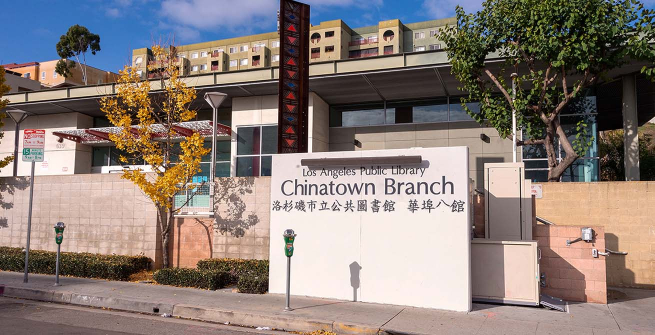With locations all over the city, and lots of books and other materials devoted to local history, libraries are a perfect springboard for exploring Los Angeles. This is the first in a series of blog posts that digs into local history near a branch of the Los Angeles Public Library. First up is the Chinatown Branch, which is surrounded by the remnants of Los Angeles’ earliest communities and multicultural neighborhoods.

The Chinatown Branch has a relatively young history compared to the community it serves. Beginning in the early 1970s, women such as Joyce Law of the Chinatown Service Center, philanthropist/fundraiser Dolores Wong, and community activist/school librarian Dr. Ruby Ling Louie fought for the establishment of a library branch in Chinatown. The search for an initial location was problematic but thanks to their persistence, a branch was opened in 1977 in the auditorium at Castelar Elementary School. The library was immediately popular and quickly outgrew the auditorium. [This brochure from the April 1983 dedication offers a glimpse into the struggles for a branch.] A robust Friends of the Library group, led by Dr. Ruby Ling Louie, raised donations to improve the library and helped fund a permanent location. The library moved into its new home at 639 N. Hill in 2003. The branch has the largest Chinese collection, and materials in English pertaining to Chinese authors and culture, in the Los Angeles Public Library system. The library’s location makes it a perfect springboard for exploring local history within a short walk or drive of the library.
Explore nearby history

The origins of Los Angeles are celebrated at El Pueblo de Los Ángeles Historical Monument (aka the Los Angeles Plaza Historic District), just half a mile southwest of the Chinatown Branch. That is where you can visit a 19th-century church (Plaza Church), the oldest firehouse in the city (Plaza Firehouse), the oldest residential building (Avila Adobe), the Pico House (a former hotel built by former California governor Pio Pico in 1869), multiple museums (visit the Chinese American Museum to see the last remaining building of Old Chinatown)—all for free. The resources listed below also offer opportunities to learn about the Mexican, Italian, French, and Chinese communities that lived near the Plaza.
Don’t miss a visit to Union Station, located across Alameda Street from El Pueblo de Los Ángeles. Dedicated in May 1939, it is the largest passenger railway station in the western United States. The architecture is striking, a mix of Streamline Moderne and Mission Revival. Construction for the building started in 1933 on the site of Old Chinatown, much of which was demolished to build the station. As a matter of fact, artifacts from Old Chinatown were unearthed during expansion of the building for the Red Line (see Greenwood’s book in the Resource list for more information).

New Chinatown, which opened June 25, 1938, is a five minute walk north of the Chinatown Branch. The architecture of New Chinatown is beautiful. The library has materials on the history of Los Angeles’ Chinatowns, both Old Chinatown and New Chinatown, as well as Christine Sterling’s ill-fated China City (which burned twice). Although the buildings of the Old Chinatown and China City are gone, you can (virtually at least) visit them through Tessa, the library’s digitized photo collection. In addition to materials documenting the city’s built environment, the Chinatown Branch has several books that contain oral histories or interviews with people who lived in Old and/or New Chinatown.

Further north, the Los Angeles State Historic Park on Spring Street is a little more than half a mile from the Chinatown Branch. During the last quarter of the 19th-century Southern Pacific Railway’s River Station graced this spot. When no longer needed for passenger trains, the station building became a mission. (Free with your library card: access the November 25, 1940 Los Angeles Times to learn about the station’s history on the eve of its destruction). Cobblestones attributed to the railyard are still visible near the southern entrance of the park. Additionally, a portion of the zanja madre, the 19th-century ditch that carried water from the Los Angeles River to El Pueblo de Los Ángeles, can be viewed from the park’s Roundhouse Bridge. The 32-acre park features several works of public art, views of downtown Los Angeles and will soon host a weekly farmers market. Visit the park’s website for more information.
Local history is made everyday

Library spaces and librarians also serve as resources for learning about neighborhoods and communities today. While visiting the Chinatown Branch I learned about two new pocket parks near the library. The Ord and Yale Street Park, located adjacent to the library, opened in 2021. When I visited, kids were playing on the park’s playground, and several people were running the adjacent Heavenly Stairs up the hillside. The park also has exercise equipment, picnic tables (tip: nearby Philippe the Original, founded by French immigrant Philippe Mathieu in 1908, is a great place to grab a sandwich), plus beautifully landscaped serene surroundings complete with a bubbling waterfall. Another new pocket park is located at the nearby corner of West Cesar Estrada Chavez Avenue and Grand Avenue. A former traffic island has been transformed into a park honoring the contributions of Croatian Americans and Italian Americans in Los Angeles. Plaques throughout the park discuss their significance, and commemorate Mother Frances Xavier Cabrini’s Regina Coeli orphanage which was once nearby. The park is beautifully landscaped and, thanks to the trees, offers shaded benches.
Not only can you discover the history of Los Angeles through the books, maps, newspapers, city directories, and photos available at the library, you can use the library to create a “road trip'' within your town. What part of Los Angeles have you always been curious about? Start at the local library and ask the librarian about neighborhood landmarks. Explore the city, meet people who live in the neighborhood, and check out the historical places you’ve only read about.

![Union Station [Photo dated 1940]](/sites/default/files/media/images/blog-lapl/2022/Dig_branches/chinatown4.jpg)


























